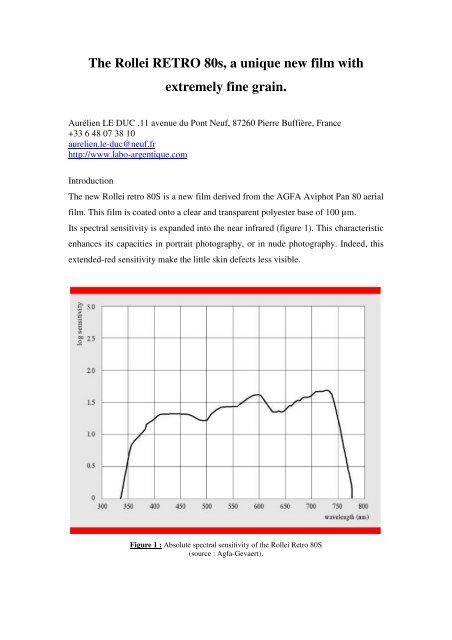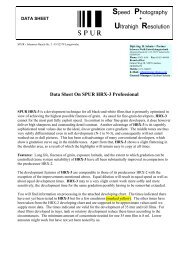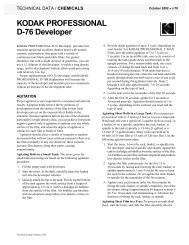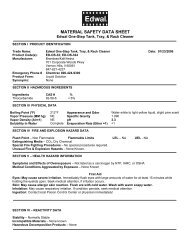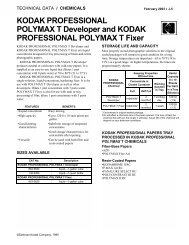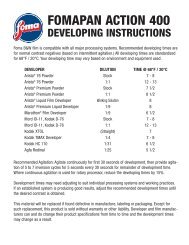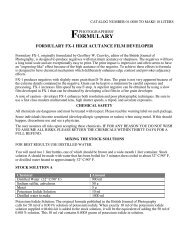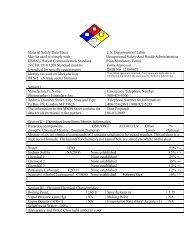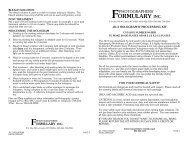The Rollei RETRO 80s, a unique new film with ... - Ars-Imago
The Rollei RETRO 80s, a unique new film with ... - Ars-Imago
The Rollei RETRO 80s, a unique new film with ... - Ars-Imago
You also want an ePaper? Increase the reach of your titles
YUMPU automatically turns print PDFs into web optimized ePapers that Google loves.
<strong>The</strong> <strong>Rollei</strong> <strong>RETRO</strong> <strong>80s</strong>, a <strong>unique</strong> <strong>new</strong> <strong>film</strong> <strong>with</strong><br />
extremely fine grain.<br />
Aurélien LE DUC ,11 avenue du Pont Neuf, 87260 Pierre Buffière, France<br />
+33 6 48 07 38 10<br />
aurelien.le-duc@neuf.fr<br />
http://www.labo-argentique.com<br />
Introduction<br />
<strong>The</strong> <strong>new</strong> <strong>Rollei</strong> retro 80S is a <strong>new</strong> <strong>film</strong> derived from the AGFA Aviphot Pan 80 aerial<br />
<strong>film</strong>. This <strong>film</strong> is coated onto a clear and transparent polyester base of 100 µm.<br />
Its spectral sensitivity is expanded into the near infrared (figure 1). This characteristic<br />
enhances its capacities in portrait photography, or in nude photography. Indeed, this<br />
extended-red sensitivity make the little skin defects less visible.<br />
Figure 1 : Absolute spectral sensitivity of the <strong>Rollei</strong> Retro 80S<br />
(source : Agfa-Gevaert).
In this document, I will tell you the results of my tests, realized <strong>with</strong> the rollei<br />
Retro 80S in format 120. As this <strong>film</strong> purpose is to obtain very fine grain<br />
photographers, I used appropriate developers like <strong>Rollei</strong> Low Speed, PMK, and<br />
HC110.<br />
I- <strong>Rollei</strong> Retro 80S and RLS :<br />
<strong>The</strong> RLS is a Perceptol®-like developer. Very fine grain, but slower <strong>film</strong> speed.<br />
<strong>The</strong> first tests were carried out to reach a speed of ISO 25. Shots were realized <strong>with</strong> a<br />
Mamiya RB67 and a 127mm lens. Light was measured <strong>with</strong> a Sekonic L308S<br />
flashmeter.<br />
Developing conditions :<br />
<strong>The</strong> <strong>film</strong> was developed in a small tank (Jobo 1500 serie tank and reel), in<br />
RLS diluted 1+4 at 24°C for 10,5 minutes. During development, 5 inversions were<br />
realized every 30 seconds, as recommended by the supplier. At the end of the<br />
developing time, the <strong>film</strong> was sunk in a 3% acetic acid bath (from Téténal) as a stop<br />
bath and then 6 minutes in fixer (SuperFix from Téténal, diluted 1+4). <strong>The</strong>n the <strong>film</strong><br />
was washed <strong>with</strong> the method developped by Didier Carré (<strong>film</strong> was washed ten times<br />
during ten minutes and the final rinse was realized <strong>with</strong> distilled water containing<br />
Ilfotol wetting agent (dilution recommended by Ilford 1+200).<br />
<strong>The</strong> second test was carried out to reach a speed of ISO 50. Shooting<br />
conditions were the same as previously.<br />
To reach such a speed, the <strong>film</strong> needed to be developped 13,5 minutes in RLS<br />
in the same conditions as what I described before.<br />
As a conclusion, <strong>Rollei</strong> Low Speed developer gives very reliable results <strong>with</strong> the<br />
<strong>Rollei</strong> Retro 80S <strong>film</strong>. Indeed it gives very thin grain, a very large grey scale, deep<br />
blacks, and highlights are not burnt. Due to the nature of this deep developer, very<br />
similar to Ilford Perceptol, nominal speed (ISO 80) of this <strong>film</strong> can’t be reached.
Figure 2 : Example of photograph realized <strong>with</strong> <strong>Rollei</strong> Retro 80S (rated at ISO 25) developped in RLS.<br />
Black box correspond to the enlarged part shown in figure 3.<br />
Figure 3 : Crop extract from figure 2 (black box)
Figure 4 : Example of photograph realized <strong>with</strong> <strong>Rollei</strong> Retro 80S (rated at ISO 50) developped in RLS.<br />
Black box correspond to the enlarged part shown in figure 5.<br />
Figure 5: Crop extract from figure 4 (black box)
Figure 6 : Example of photograph realized <strong>with</strong> <strong>Rollei</strong> Retro 80S (rated at ISO 50) developped in RLS.<br />
Black box correspond to the enlarged part shown in figure 7.<br />
Figure 7: Crop extract from figure 6 (black box)
II- <strong>Rollei</strong> Retro 80S and PMK :<br />
PMK (Pyrogallol Metol Kodalk) is a staining developer used since the XIXe<br />
century. Due to the toxicity of its main component, pyrogallol, this developer was a<br />
bit given up. A few decades ago, Gordon Hutching has reintroduced it and promoted<br />
its use, writing “the book of Pyro”.<br />
As a lover of the former fortepan 200, I used a lot PMK that gave outstanding<br />
results of fine grain, large greyscale, and has a very compensative effect, resulting in<br />
very easy printing of the negatives. That’s why I decided to test the <strong>Rollei</strong> Retro 80S<br />
in PMK. Unfortunately, the first results were very disappointing. Indeed, the staining<br />
effect was so important that <strong>film</strong> was mostly opaque. That’s why modifications of the<br />
operating methods were required.<br />
Developing conditions:<br />
Shots were made <strong>with</strong> Mamiya RB67, 127mm lens and light was measured<br />
<strong>with</strong> my sekonic L308S.<br />
Film was developed in PMK diluted 1+2+100 for 9 minutes at 24°C, <strong>with</strong> 2<br />
inversions every 15 seconds. <strong>The</strong>n <strong>film</strong> was sunk in running water at 24°C for one<br />
minute and then in TF-4 fixer (diluted 1+4) at 24°C too. Contrarily to what is<br />
recommended by the supplier, I did not reuse the already used developer as an alkali<br />
bath to increase the yellow staining. This is the only way to have good results <strong>with</strong><br />
this <strong>film</strong> in PMK. Wash was then realized as described previously.
Figure 8 : Example of photograph realized <strong>with</strong> <strong>Rollei</strong> Retro 80S (rated at ISO 80) developped in<br />
PMK. White box correspond to the enlarged part shown in figure 9.<br />
Figure 9: Crop extract from figure 8 (white box)
III- <strong>Rollei</strong> Retro 80S and HC110 :<br />
HC110 form Kodak is one of the most used developer in the world. Very easy to<br />
prepare, and developing times are proportional to its dilution. An example? Dilution<br />
H is twice as diluted as dilution B. Times are twice as long in H than in B! So easy.<br />
So why don’t I try HC110 <strong>with</strong> the <strong>Rollei</strong> retro 80S?<br />
Developing conditions:<br />
Shots were made <strong>with</strong> Mamiya RB67, 127mm lens and light was measured<br />
<strong>with</strong> my sekonic L308S.<br />
<strong>The</strong> <strong>film</strong> was developed in a small tank (Jobo 1500 serie tank and reel), in HC110<br />
(dilution H) at 24°C for 10 minutes (11 minutes for ISO 160). During development,<br />
10 inversions were realized every minute. Stop bath, fixing and washing were made<br />
as already described in the RLS description process.<br />
This developer also allowed the <strong>film</strong> to reach ISO 160 speed.<br />
Figure 10 : Example of photograph realized <strong>with</strong> <strong>Rollei</strong> Retro 80S (rated at ISO 160) developped in<br />
HC110. White box correspond to the enlarged part shown in figure 11.
Figure 11: Crop extract from figure 10 (white box)<br />
Recommended developing times:<br />
<strong>Rollei</strong> Low Speed<br />
(1+4 / 24°C)<br />
PMK<br />
(1+2+100 / 24°C)<br />
HC110<br />
(H / 24°C)<br />
ISO 25 10,5 minutes ND ND<br />
ISO 50 13,5 minutes ND ND<br />
ISO 80 NR 9 minutes 10 minutes<br />
ISO 160 NR NR 11 minutes<br />
(NR: not recommended / ND: not determined)<br />
So in conclusion, if you want:<br />
- very fine grain : use RLS<br />
- box speed, compensative effect, fine grain : use PMK<br />
- easy preparation, not expensive developer, and good compromise: use<br />
HC110<br />
A further comparison between all the low speed <strong>film</strong>s (APX25, <strong>Rollei</strong> Pan 25, Efke<br />
25 and <strong>Rollei</strong> Retro 80S is coming…


